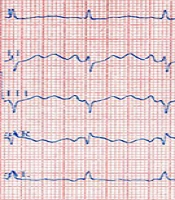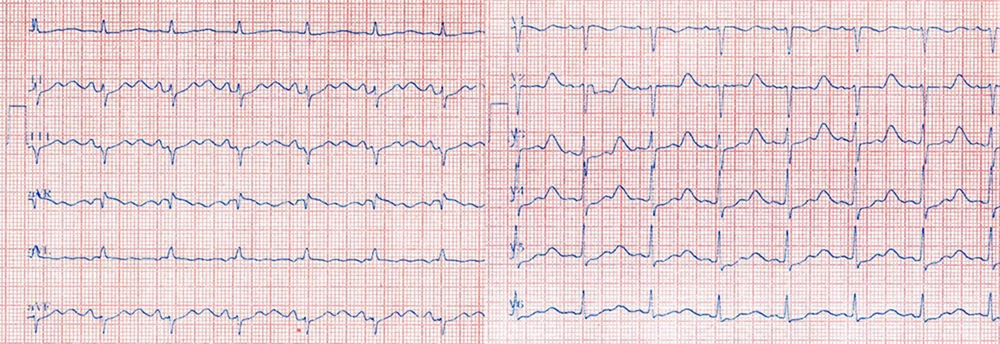1. Introduction
Methadone has been known as a common treatment for opioids addiction and pain relief. However, it may have adverse effects on the respiratory and cardiovascular systems, and its mortality and morbidity have been increased. This might be due to overdoses or chronic usage, mostly more than 100 mg/d. In cardiovascular system, methadone induces prolongation of QT interval and lethal ventricular arrhythmia, especially polymorphic ventricular arrhythmia (1).
2. Case Presentation
A 41-year-old man with a history of nausea, recurrent vomiting, and epigastric pain for five hours referred to the emergency department. He was a drug user and had used 50 cc (250 mg) of methadone every night for the past six years, plus some extra doses in the last week. At admission, he was monitored, and had a normal mental state, vital signs, and physical exams. His first electrocardiogram (ECG) showed a long QT interval (Figure 1; corrected QT (QTc) interval = 630 msec). Initial laboratory testing revealed that the serum potassium, calcium, and magnesium levels were normal.
Six hours after admission, the patient’s rhythm on the monitor exhibited short-coupled premature ventricular contraction (PVC) in a pattern of bigeminy that triggered Torsades de Pointes for about 30 seconds (Figure 2) and was spontaneously converted to sinus rhythm before making any interventions. The patient became unconscious during this short period.
In the acute phase, the patient was treated with intravenous magnesium and lidocaine. He was discharged after congenital long QT syndromes were ruled out. He received counseling for cessation of addiction and a ban on methadone.
3. Discussion
The long corrected QT Interval (QTc) in adult women and men is defined as QTc > 470, QTc > 450 msec. Prolonged QTc interval, especially if more than 500 msec, increases the risk of lethal arrhythmia, which can be presented as presyncope, syncope, aborted sudden cardiac death, and sudden cardiac death.
Prolongation of myocardial repolarization can manifest itself in the ECG as a prolonged QT interval. It also generates early after depolarization that triggers PVC proceeding to polymorphic ventricular tachycardia known as Torsades de Pointes, which is usually self-limited but can progress to ventricular fibrillation as a life threatening arrhythmia. The most common cause of acquired long QT syndromes in patients with a normal physiological and structural cardiovascular system is the use of medications (2).
Chronic high-dose methadone usage inhibits the rapid part of the delayed rectifier potassium current (IKr) during myocardial repolarization, leading to prolongation of QT interval. This effect is usually dose-dependent and almost arrhythmia does not occur in the beginning days of using methadone (1). The chronic methadone consumers are prone to have some conditions that facilitates prolongation of QTc interval and causes Torsades de Pointes, such as electrolyte imbalance (hypokalemia and hypocalcemia), bradycardia, severe structural heart disease, and use of other drugs inducing long QT interval (antidepressants, etc.) (3).


